Bullet
1. the bullet, as the projectile;
2. the case, which holds all parts together;
3. the propellant, for example gunpowder or cordite;
4. the rim, which provides the extractor on the firearm a place to grip the casing to remove it from the chamber once fired;
5. the primer, which ignites the propellant.
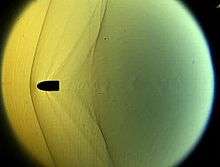
A bullet is a projectile propelled by a firearm, sling, slingshot, or air gun. Bullets do not normally contain explosives,[1] but damage the intended target by impact and penetration. The word "bullet" is sometimes colloquially used to refer to ammunition in general, or to a cartridge, which is a combination of the bullet, case/shell, powder, and primer. This use of 'bullet', when 'cartridge' is intended, leads to confusion when the components of a cartridge are discussed or intended.
Bullets fired from slings, slingshots, and many airguns (including BB guns) travel well below the speed of sound (about 343 m/s or 1126 ft/s in dry air at 20 °C or 68 °F). Low-power handguns have muzzle velocities generally less than the speed of sound (subsonic), while bullets fired from high-power handguns (such as a .44 Magnum) and from rifles have an initial speed faster than the speed of sound, meaning they are supersonic and thus can travel a substantial distance and even hit a target before a nearby observer hears the "bang" of the shot. Bullet speed through air depends on a number of factors such as barometric pressure, humidity, air temperature, and wind speed.[2][3]
History

The history of bullets far predates the history of firearms. For instance, ammunition for crossbows could have been spherical in addition to shooting crossbow bolts. In discussing astronomical topics such as solar and lunar eclipses, the Western-Han era Chinese mathematician and music theorist Jing Fang (78-37 BC) wrote that the moon, shaped like a ball, produced no light and was illuminated only by the sun, which he compared to the shape of a round crossbow bullet.[4] Originally, bullets were made out of stone or purpose-made clay balls used as sling ammunition, as weapons and for hunting. Eventually as firearms were developed, these same items were placed in front of a propellant charge of gunpowder at the end of a closed tube. As firearms became more technologically advanced, from 1500 to 1800, bullets changed very little. They remained simple round (spherical) lead balls, called rounds, differing only in their diameter.
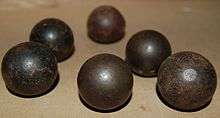
The development of the hand culverin and matchlock arquebus brought about the use of cast lead balls as projectiles. "Bullet" is derived from the French word boulette, which roughly means little ball. The original musket bullet was a spherical lead ball smaller than the bore, wrapped in a loosely fitted paper patch that held the bullet firmly in the barrel and against the powder. (Bullets not firmly on the powder risked exploding the barrel, with the condition known as a short start.) The loading of muskets was, therefore, easy with the old smooth-bore Brown Bess and similar military muskets. The original muzzle-loading rifle, on the other hand, with a more closely fitting ball to take the rifling grooves, was more difficult to load, particularly when the bore of the barrel was fouled from previous firings. For this reason, early rifles were not generally used for military purposes.
The first half of the nineteenth century saw a distinct change in the shape and function of the bullet. In 1826, Delvigne, a French infantry officer, invented a breech with abrupt shoulders on which a spherical bullet was rammed down until it caught the rifling grooves. Delvigne's method, however, deformed the bullet and was inaccurate.
Square bullets have origins that almost pre-date civilization and were used by slingers in slings. They were typically made out of copper or lead. The most notable use of square bullet designs was done by, James Puckle and Kyle Tunis who patented them, where they were briefly used in one version of the Puckle gun. The early use of these in the black-powder era was soon discontinued due to irregular and unpredictable flight patterns.
Pointed bullets
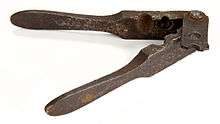
Among the first pointed or "conical" bullets were those designed by Captain John Norton of the British Army in 1823. Norton's bullet had a hollow base that, on firing, expanded under pressure to engage with a barrel's rifling. The British Board of Ordnance rejected it because spherical bullets had been in use for the previous 300 years.
Renowned English gunsmith William Greener invented the Greener bullet in 1836. It was similar to Norton's bullet, except that Greener fitted the hollow base of the bullet with a wooden plug that more reliably forced the base of the bullet to expand and catch the rifling. Tests proved that Greener's bullet was extremely effective, but the military rejected it too because, being two parts, they judged it as too complicated to produce.
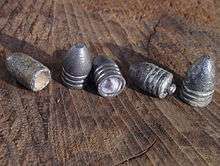
The soft lead Minié ball was first introduced in 1847 by Claude-Étienne Minié, a captain in the French Army. It was nearly identical to the Greener bullet. As designed by Minié, the bullet was conical in shape with a hollow cavity in the rear, which was fitted with a small iron cap instead of a wooden plug. When fired, the iron cap would force itself into the hollow cavity at the rear of the bullet, thus expanding the sides of the bullet to grip and engage the rifling. In 1855, the British adopted the Minié ball for their Enfield rifles. A similar bullet called the Nessler ball was also developed for smoothbore muskets.
The small Minié ball first saw widespread use in the American Civil War. Roughly 90% of the battlefield casualties in this war were caused by Minié balls fired from rifles.
Between 1854 and 1857, Sir Joseph Whitworth conducted a long series of rifle experiments, and proved, among other points, the advantages of a smaller bore and, in particular, of an elongated bullet. The Whitworth bullet was made to fit the grooves of the rifle mechanically. The Whitworth rifle was never adopted by the government, although it was used extensively for match purposes and target practice between 1857 and 1866, when it was gradually superseded by Metford's.
About 1862 and later, W. E. Metford carried out an exhaustive series of experiments on bullets and rifling, and invented the important system of light rifling with increasing spiral, and a hardened bullet. The combined result was that in December 1888 the Lee–Metford small-bore (0.303", 7.70 mm) rifle, Mark I, was finally adopted for the British army. The Lee–Metford was the predecessor of the Lee–Enfield.
The modern bullet
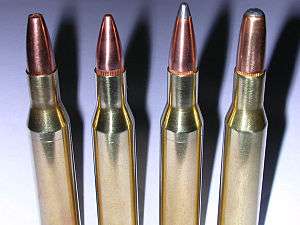
100-grain (6.5 g) – hollow point
115-grain (7.5 g) – FMJBT
130-grain (8.4 g) – soft point
150-grain (9.7 g) – round nose
The next important change in the history of the rifle bullet occurred in 1882, when Lt. Colonel Eduard Rubin, director of the Swiss Army Laboratory at Thun, invented the copper-jacketed bullet — an elongated bullet with a lead core in a copper jacket. It was also small bore (7.5mm and 8mm) and it is the precursor of the 8mm Lebel bullet adopted for the smokeless powder ammunition of the Mle 1886 Lebel rifle.
The surface of lead bullets fired at high velocity may melt due to hot gases behind and friction with the bore. Because copper has a higher melting point, and greater specific heat capacity and hardness, copper-jacketed bullets allow greater muzzle velocities.
European advances in aerodynamics led to the pointed spitzer bullet. By the beginning of the twentieth century, most world armies had begun to transition to spitzer bullets. These bullets flew for greater distances more accurately and carried more energy with them. Spitzer bullets combined with machine guns greatly increased the lethality of the battlefield.
The latest advancement in bullet shape was the boat tail, a streamlined base for spitzer bullets. The vacuum created as air moving at high speed passes over the end of a bullet slows the projectile. The streamlined boat tail design reduces this form drag by allowing the air to flow along the surface of the tapering end. The resulting aerodynamic advantage is currently seen as the optimum shape for rifle technology. The first combination spitzer and boat-tail bullet, named Balle "D" from its inventor (a lieutenant-colonel Desaleux), was introduced as standard military ammunition in 1901, for the French Lebel Model 1886 rifle.
A ballistic tip bullet is a hollow-point rifle bullet that has a plastic tip on the end of the bullet itself. This improves external ballistics by streamlining the bullet, allowing it to cut through the air more easily, and improves terminal ballistics by allowing the bullet to act as a JHP on impact.
As a side effect, it also feeds better in weapons that have trouble feeding rounds that are not FMJ rounds.
Design

Bullet designs have to solve two primary problems. In the barrel, they must first form a seal with the gun's bore. If a strong seal is not achieved, gas from the propellant charge leaks past the bullet, thus reducing efficiency and possibly accuracy. The bullet must also engage the rifling without damaging or excessively fouling the gun's bore, and without distorting the bullet, which will also reduce accuracy. Bullets must have a surface that forms this seal without excessive friction. These interactions between bullet and bore are termed internal ballistics. Bullets must be produced to a high standard, as surface imperfections can affect firing accuracy.
The physics affecting the bullet once it leaves the barrel is termed external ballistics. The primary factors affecting the aerodynamics of a bullet in flight are the bullet's shape and the rotation imparted by the rifling of the gun barrel. Rotational forces stabilize the bullet gyroscopically as well as aerodynamically. Any asymmetry in the bullet is largely canceled as it spins. However, a spin rate greater than the optimum value adds more trouble than good, by magnifying the smaller asymmetries or sometimes resulting in the bullet exploding midway in flight. With smooth-bore firearms, a spherical shape was optimum because no matter how it was oriented, it presented a uniform front. These unstable bullets tumbled erratically and provided only moderate accuracy; however, the aerodynamic shape changed little for centuries. Generally, bullet shapes are a compromise between aerodynamics, interior ballistic necessities, and terminal ballistics requirements. Another method of stabilization is to place the center of mass of the bullet as far forward as is practical, which is how the Minié ball and the shuttlecock are designed. This makes the bullet fly front-forward by means of aerodynamics.
See the articles on terminal ballistics and/or stopping power for an overview of how bullet design affects what happens when a bullet impacts with an object. The outcome of the impact is determined by the composition and density of the target material, the angle of incidence, and the velocity and physical characteristics of the bullet itself. Bullets are generally designed to penetrate, deform, or break apart. For a given material and bullet, the strike velocity is the primary factor that determines which outcome is achieved.
Bullet shapes are many and varied, and an array of them can be found in any reloading manual that sells bullet moulds. Mould manufacturers such as RCBS,[5] Paul Jones Moulds, and David Mos offer many different calibers and designs. With a mould, bullets can be made at home for reloading one's own ammunition, where local laws allow. Hand-casting, however, is only time- and cost-effective for solid lead bullets. Cast and jacketed bullets are also commercially available from numerous manufacturers for hand loading and are much more convenient than casting bullets from bulk lead.
Propulsion
Propulsion of the ball can happen via several methods:
- by using only gunpowder (i.e. as in flintlock weapons)
- by using a percussion cap and gunpowder (i.e. as in percussion weapons)
- by using a cartridge (which contains primer, gunpowder and bullet in a single package)
Materials
Bullets for black powder, or muzzle-loading firearms, were classically molded from pure lead. This worked well for low-speed bullets, fired at velocities of less than 450 m/s (1475 ft/s). For slightly higher-speed bullets fired in modern firearms, a harder alloy of lead and tin or typesetter's lead (used to mold Linotype) works very well. For even higher-speed bullet use, jacketed coated lead bullets are used. The common element in all of these, lead, is widely used because it is very dense, thereby providing a high amount of mass—and thus, kinetic energy—for a given volume. Lead is also cheap, easy to obtain, easy to work, and melts at a low temperature, which results in comparatively easy fabrication of bullets.
- Lead: Simple cast, extruded, swaged, or otherwise fabricated lead slugs are the simplest form of bullets. At speeds of greater than 300 m/s (1000 ft/s) (common in most handguns), lead is deposited in rifled bores at an ever-increasing rate. Alloying the lead with a small percentage of tin and/or antimony serves to reduce this effect, but grows less effective as velocities are increased. A cup made of harder metal, such as copper, placed at the base of the bullet and called a gas check, is often used to decrease lead deposits by protecting the rear of the bullet against melting when fired at higher pressures, but this too does not solve the problem at higher velocities.
- Jacketed lead: Bullets intended for even higher-velocity applications generally have a lead core that is jacketed or plated with gilding metal, cupronickel, copper alloys, or steel; a thin layer of harder metal protects the softer lead core when the bullet is passing through the barrel and during flight, which allows delivering the bullet intact to the target. There, the heavy lead core delivers its kinetic energy to the target. Full metal jacket or "ball" bullets (cartridges with ball bullets (which despite the name are not spherical) are called ball ammunition) are completely encased in the harder metal jacket, except for the base. Some bullet jackets do not extend to the front of the bullet, to aid expansion and increase lethality; these are called soft point (if the exposed lead tip is solid) or hollow point bullets (if a cavity or hole is present). Steel bullets are often plated with copper or other metals for corrosion resistance during long periods of storage. Synthetic jacket materials such as nylon and Teflon have been used, with limited success, especially in rifles; however, hollow point bullets with plastic aerodynamic tips have been very successful at both improving accuracy and enhancing expansion. Newer plastic coatings for handgun bullets, such as Teflon-coated bullets, are making their way into the market.
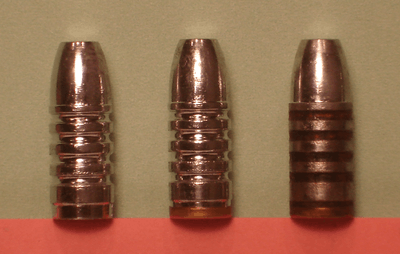
- Solid or Monolithic Solid: mono-metal bullets intended for deep penetration in big game animals and slender shaped very-low-drag projectiles for long range shooting are produced out of metals like oxygen free copper and alloys like copper nickel, tellurium copper and brass, for example highly machinable UNS C36000 Free-Cutting Brass. Often these projectiles are turned on precision CNC lathes. In the case of solids, and the ruggedness of the game animals on which they are used, e.g., the African buffalo or elephant, expansion is almost entirely relinquished for the necessary penetration. In shotgunning, "slug" loads are often solid large single lead projectiles, sometimes with a hollow point, used for deer or wild pig hunting in jurisdictions that do not allow rifles (because a missed slug shot will travel considerably less far than a rifle bullet).
- Fluted: In appearance, these are solid bullets with scalloped sides (missing material). The theory is that the flutes produce hydraulic jetting when passing through tissues, creating a wound channel larger than that made by conventional expanding ammunition such as hollowpoints.
- Hard Cast: A hard lead alloy intended to reduce fouling of rifling grooves (especially of the polygonal rifling used in some popular pistols). Benefits include simpler manufacture than jacketed bullets and good performance against hard targets; limitations are an inability to mushroom and subsequent over-penetration of soft targets.
- Blanks: Wax, paper, plastic, and other materials are used to simulate live gunfire and are intended only to hold the powder in a blank cartridge and to produce noise, flame and smoke. The "bullet" may be captured in a purpose-designed device or it may be allowed to expend what little energy it has in the air. Some blank cartridges are crimped or closed at the end and do not contain any bullet; some are fully loaded cartridges (without bullets) designed to propel rifle grenades. Note that blank cartridges, at short ranges, can be lethal due to the force of the expanding gas - numerous tragic accidents have occurred with blank cartridges (e.g., the death of actor Jon-Erik Hexum).
- Practice: Made from lightweight materials like rubber, wax, wood, plastic, or lightweight metal, practice bullets are intended for short-range target work, only. Because of their weight and low velocity, they have limited range.
- Polymer: These are metal-polymer composites, generally lighter and higher velocity than a pure metal bullet of the same dimensions. They permit unusual designs that are difficult with conventional casting or lathing.
- Less lethal, or Less than Lethal: Rubber bullets, plastic bullets, and beanbags are designed to be non-lethal, for example for use in riot control. They are generally low velocity and are fired from shotguns, grenade launchers, paint ball guns, or specially designed firearms and air gun devices.
- Incendiary: These bullets are made with an explosive or flammable mixture in the tip that is designed to ignite on contact with a target. The intent is to ignite fuel or munitions in the target area, thereby adding to the destructive power of the bullet itself.
- Exploding: Similar to the incendiary bullet, this type of projectile is designed to explode upon hitting a hard surface, preferably the bone of the intended target. Not to be mistaken for cannon shells or grenades with fuse devices, these bullets have only a cavity filled with a small amount of low explosive depending on the velocity and deformation upon impact to detonate. Exploding bullets have been used on various aircraft machine guns and on anti materiel rifles.
- Tracer: These have a hollow back, filled with a flare material. Usually this is a mixture of magnesium metal, a perchlorate, and strontium salts to yield a bright red color, although other materials providing other colors have also sometimes been used. Tracer material burns out after a certain amount of time. Such ammunition is useful to the shooter as a means of learning how to point shoot moving targets with rifles. This type of round is also used by all branches of the United States military in combat environments as a signaling device to friendly forces. Normally it is loaded at a four to one ratio with ball ammunition and is intended to show where you are firing so friendly forces can engage the target as well. The flight characteristics of tracer rounds differ from normal bullets due to their lighter weight.
- Armor-piercing: Jacketed designs where the core material is a very hard, high-density metal such as tungsten, tungsten carbide, depleted uranium, or steel. A pointed tip is often used, but a flat tip on the penetrator portion is generally more effective.[6]
- Nontoxic shot: Steel, bismuth, tungsten, and other exotic bullet alloys prevent release of toxic lead into the environment. Regulations in several countries mandate the use of nontoxic projectiles especially when hunting waterfowl. It has been found that birds swallow small lead shot for their gizzards to grind food (as they would swallow pebbles of similar size), and the effects of lead poisoning by constant grinding of lead pellets against food means lead poisoning effects are magnified. Such concerns apply primarily to shotguns, firing pellets (shot) and not bullets, but there is evidence suggesting that consumption of spent rifle and pistol ammunition is also hazardous to wildlife.[7] Reduction of hazardous substances (RoHS) legislation has also been applied to bullets on occasion to reduce the impact of lead on the environment at shooting ranges. United States Environmental Protection Agency announced that the agency does not have the legal authority to regulate this type of product (lead bullets) under the Toxic Substances Control Act (TSCA), nor is the agency seeking such authority. NRA-ILA :: EPA Denies Ammo Ban Petition With some nontoxic shot, e.g., steel shot, care must be taken to shoot only in shotguns (and with chokes) specifically designed and designated for steel shot; for other, particularly older, shotguns, serious damage to the barrel and chokes can occur. And, because steel is lighter and less dense than lead, larger sized pellets must be used, thus reducing the number of pellets in a given charge of shot and possibly limiting patterns on the target; other formulations, e.g. bismuth, do not present this disability.
- Blended-metal: Bullets made using cores from powdered metals other than lead with binder or sometimes sintered.
- Frangible: Designed to disintegrate into tiny particles upon impact to minimize their penetration for reasons of range safety, to limit environmental impact, or to limit the shoot-through danger behind the intended target. An example is the Glaser Safety Slug, usually a pistol caliber bullet made from an amalgam of lead shot and a hard (and thus frangible) plastic binder designed to penetrate a human target and release its component shot pellets without exiting the target.
- Multiple impact bullet: Bullets that are made of separate slugs that fit together inside the cartridge, and act as a single projectile inside the barrel as they are fired. The projectiles part in flight, but are held in formation by tethers that keep the individual parts of the "bullet" from flying too far away from each other. The intention of such ammo is to increase hit chance by giving a shot like spread to rifled slug firing guns, while maintaining a consistency in shot groupings. Multiple impact bullets may be less stable in flight than conventional solid bullets because of the added aerodynamic drag from the tether line holding the pieces in formation, and each projectile affects the flight of all the others. This may limit the benefit provided by the spread of each bullet at longer ranges.
Treaties and prohibitions
Poisonous bullets were a subject to an international agreement as early as the Strasbourg Agreement (1675).
The St. Petersburg Declaration of 1868 prohibited the use of explosive projectiles weighing less than 400 grams.[8]
The Hague Convention prohibits certain kinds of ammunition for use by uniformed military personnel against the uniformed military personnel of opposing forces. These include projectiles that explode within an individual, poisoned and expanding bullets.
Protocol III of the 1983 Convention on Certain Conventional Weapons, an annexe to the Geneva Conventions, prohibits the use of incendiary ammunitions against civilians.
Nothing in these treaties prohibits tracers or the use of prohibited bullets on military equipment.
These treaties apply even to .22 LR bullets used in pistols, rifles and machine guns. Hence, the High Standard HDM pistol, a .22 LR suppressed pistol, had special bullets developed for it during World War II that were full metal jacketed, in place of the soft-point and hollow-point bullets that are otherwise ubiquitous for .22 LR rounds.
Some jurisdictions acting on environmental concerns have banned hunting with lead bullets and shotgun pellets.[9]
In December 2014, a federal appeals court denied a lawsuit by environmental groups that the EPA must use the Toxic Substances Control Act to regulate lead in shells and cartridges. The groups sought to regulate "spent lead", yet EPA could not regulate spent lead without also regulating cartridges and shells, per the court.[10]
Bullet abbreviations
|
|
|
See also
- Bullet bow shockwave
- Grain (unit)
- Gunpowder
- List of handgun cartridges
- List of rifle cartridges
- Meplat
- Multiple projectile ammunition
- Projectile
- Propellant
- Shotgun shells
- Smart bullet
- Smokeless powder
- Special Purpose Individual Weapon
- Table of handgun and rifle cartridges
References
- ↑ The Exploding Bullet Journal of Clinical Pathology
- ↑ https://www.youtube.com/watch?v=eneaN4h-qBs HOW fast bullet travels
- ↑ http://www.mythbusterstheexhibition.com/science-content/dodge-a-bullet/ DODGE A BULLET
- ↑ Needham, Joseph (1986). Science and Civilization in China: Volume 3, Mathematics and the Sciences of the Heavens and the Earth. Taipei: Caves Books Ltd, p. 227.
- ↑ "RCBS". RCBS. Retrieved 2012-08-10.
- ↑ Hughes, David (1990). The History and Development of the M16 Rifle and Its Cartridge. Oceanside: Armory Pub. ISBN 978-0-9626096-0-2.
- ↑ "Research--Eagles and Lead.". SOAR Raptor Foundation.
- ↑ Glover, William H. "Purposes and Basic Principles of the Law of War". Retrieved 2010-07-28.
- ↑ "Nonlead Ammunition".
- ↑ Zack Colman (December 23, 2014). "EPA can't regulate lead bullets, says federal court". Washington Examiner. Retrieved 30 December 2014.
- ↑ "Bullet Basics 1- Materials; Remington Accelerator (at bottom of page)". Firearmsid.com. Retrieved 2012-08-10.
- ↑ Archived October 8, 2011, at the Wayback Machine.
- ↑ Archived January 3, 2012, at the Wayback Machine.
- ↑ "RWS | Rottweil: RWS | Rottweil". Jagd.rottweil-munition.de. Archived from the original on August 18, 2011. Retrieved 2012-08-08.
- ↑ "RWS | Rottweil: RWS | Rottweil". Jagd.rottweil-munition.de. Archived from the original on August 18, 2011. Retrieved 2012-08-08.
- ↑ BGB Enterprises. "Lead Bullets Technology - Premium Molds". Lbtmoulds.com. Retrieved 2012-08-10.
- ↑ "TAG". Brenneke-munition.de. 2008-01-24. Retrieved 2012-08-08.
- ↑ "TIG". Brenneke-munition.de. 2008-01-24. Retrieved 2012-08-08.
- ↑ "TUG". Brenneke-munition.de. Retrieved 2012-08-08.
- ↑ "TOG". Brenneke-munition.de. 2008-01-24. Retrieved 2012-08-08.
- ↑ "RWS | Rottweil: RWS | Rottweil". Jagd.rottweil-munition.de. Archived from the original on August 18, 2011. Retrieved 2012-08-08.
External links
| Look up bullet in Wiktionary, the free dictionary. |
| Wikimedia Commons has media related to bullets. |
- High speed imaging of in flight bullet transition ballistics
- "Bullets by the Billion", 1946 - Story about the manufacture of small caliber ammunition during World War II
- Arizona Gun List - ammunition types
- Bullets for Beginners
- Dangerous Game Bullets
- European Ammunition Box Translations
- Remington Core-Lokt, Bronze Point & Power-Lokt Centerfire Ammunition


